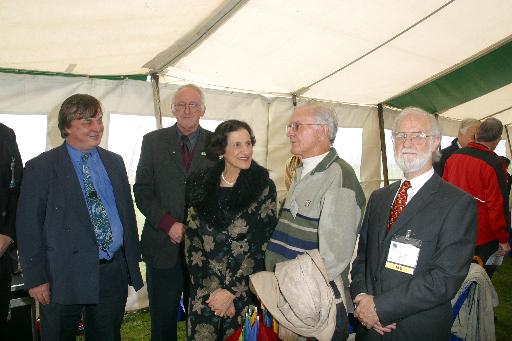A celebration at Dover Heights
Rodney Reserve, on the cliff tops at Dover Heights in the eastern suburbs of Sydney was one of the most remarkable and important astronomical sites in New South Wales. Between 1946 and 1954, this former WWII radar station was the leading field station of the CSIRO Division of Radiophysics, and was home to a succession of different radio telescopes that were used to make outstanding advances in radio astronomy. Around 120 new radio sources were detected at Dover Heights. These were identified as gaseous nebulae in our own Galaxy, and as powerful sources of radio waves from distant galaxies. These discoveries showed that radio waves could be used to study the universe "from the solar system to the Cosmos" and firmly established Australia as a world leader in the emerging new science of radio astronomy.
To celebrate the history and achievements of the Dover Heights site, in November 2002, the ATNF submitted an application to the Waverley Council to build a scientific memorial on the site, consisting of a full-size replica of one of the early radio telescopes and a display panel with information about the site. After consultation with the local community and acquiring various environmental and heritage impact reports, this application was approved by the council in June 2003.
On 20 July 2003 a ceremony was held on Rodney Reserve to open the new memorial. The ceremony was timed to coincide with the historical sessions of the IAU General Assembly and many international and Australian visitors with a keen interest in the history of radio astronomy gathered for the event. Guest of honour at the ceremony was Her Excellency, Professor Marie Bashir, Governor of New South Wales. Professor Bashir gave an inspirational speech where she emphasized the importance of recognizing our scientific achievements and heroes. Other invited speakers were Professor Woody Sullivan (University of Washington, USA), Professor Ron Ekers (ATNF) and Mr Paul Pearce, Mayor of the Waverley Council.
 Professors Ray Norris, Miller Goss, Marie Bashir, Dr Bruce Slee and Professor Ron Ekers at the Dover Heights reception on 20 July 2003.
Professors Ray Norris, Miller Goss, Marie Bashir, Dr Bruce Slee and Professor Ron Ekers at the Dover Heights reception on 20 July 2003.
On the day itself the weather was atrocious with dark grey skies, wind and driving rain. Fortunately, we had a marquee set up on the reserve and this was used for the speeches and reception. A brief lull in the rain allowed everyone to venture outside for a few minutes for the unveiling of the display panel. During the afternoon several astronomers recalled stories from their earlier days. Despite the weather it was a day to remember.
A full size replica of an 8-element Yagi array that was used at Dover Heights during 1951 - 1952. This was one of several Yagi arrays that were used on the site as a "sea interferometer". In this technique, an interference pattern was recorded by combining radio waves detected directly from the source and from a reflection off the sea. The replica antenna has been installed on the cliff top next to the original mount, as a scientific memorial.
Jessica Chapman, Wayne Orchiston, John Sarkissian
(Jessica.Chapman@csiro.au)
